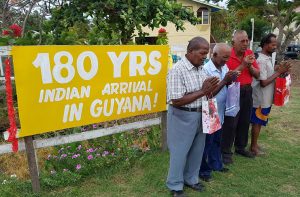By Indrawattie Natram
– with aid of mini-exhibition
HISTORIAN and former People’s Progressive Party (PPP) Member of Parliament, Mr. Isahak Basir on Saturday morning hosted a mini-exhibition and lecture on the coming of our Indian ancestors to these shores.
The programme, which was held at Basir’s Hampton Court home, began with a prayer session, after which invitees were briefed on the kind of living conditions the arrivées were subjected to when they came.

Both lecture and exhibition were in keeping with observations to mark the 180th Anniversary of the arrival of Indian nationals here and the arrival in general of peoples of other nationalities before and after the famed Atlantic Slave Trade.
During his presentation, Basir told his guests that the importation of Indian labour from all across India in 1848 to the then British Guiana was no accident, but more of a necessity to sustain the failing agriculture programmes in British colonies the world over. By 1760, he said, their sugar, coffee and cotton estates were falling apart.
He said the three most crucial developments that took place between 1760 and 1834 were the opposition of a group of English statesmen to Slavery; the enormous cost of managing rebellious slaves, and the staging of rebellions, seizing of estates and killing of white slave-masters, all in an effort to oppose slavery.
Closer to home, in what is now the County of Essequibo, Basir said, 20 of the 55 sugar estates were closed down, the last and largest being the one at Hampton Court, which was put out of commission in 1934.
He was keen to note that when the East Indians arrived in British Guiana, they found the “freed slaves” very helpful, as they offered much support in every aspect of social life, right down to identifying who among the white managers were the most vicious and dangerous.
They even lived together on occasion,sharing the logie apartments associated with estate life and indentureship back then.
Noting the significant difference between the two races in post-slavery-indentureship Guyana, Basir said, “While our African brothers despise agriculture because of the “sting of slavery”, they chose to excel in other forms of production and service.
“Some are in State machinery, gold mining, sea farming, construction and academics.
“On the other hand, the Indentured Indians who chose to remain in Guyana, approximately 200,000 of them, were able to build a strong business sector, build the rice industry, and develop the cattle industry.”
In closing, Basir said, “On this historic date of 180 years of Indian arrival in Guyana, let us strive to mould our Guyanese society, putting a blind eye on racism and small difference, and build on our human commonality.
“Our multi-cultural society must be respected and promoted; let us build a Guyanese culture for the world at large to regard us as a model of Human Society.
“We no longer have a place in India; we no longer have a place in Africa. Watan ki raah hame, Watan ki now…”
At the end of the programme, he proudly distributed Morning Glory cereal, “a proud product of Essequibo” to all those present.


.jpg)











